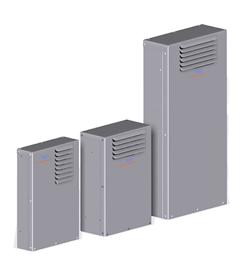Understanding Air to Air Heat Exchangers for Enclosure Cooling
 An air to air heat exchanger has the unique ability to cost effectively deliver convection cooling to heat producing electrical equipment with the advantages of a closed-loop cooling system. The closed-loop design cools and recirculates the air inside the electrical enclosure, while isolating electrical components from environments that pose contaminant problems.
An air to air heat exchanger has the unique ability to cost effectively deliver convection cooling to heat producing electrical equipment with the advantages of a closed-loop cooling system. The closed-loop design cools and recirculates the air inside the electrical enclosure, while isolating electrical components from environments that pose contaminant problems.
How Does an Air to Air Heat Exchanger Work?
The overall cooling process is a simple one where the transfer of heat always moves away from a warmer area to a cooler one. By definition, heat transfer is the movement of thermal energy from one object to another of a different temperature.
An air to air heat exchanger uses heat pipes made of copper, because copper functions as an excellent heat conductor. Surrounding the copper heat pipes are extruded fins. The use of fins around the copper heat pipes increases material surface area allowing for more and faster heat absorption and dissipation.
The sealed copper tubes contain a phase changing liquid. The liquid absorbs heat from the heated enclosure where it is converted to a vapor. This heated vapor automatically moves to the cooler end of the heat pipe which is exposed to the cooler ambient air outside the enclosure. Here, the excess heat is rapidly expelled out into the cooler ambient air and the vapor is changed back into a liquid. Once cooled, the liquid moves back once again towards the warmer end of the heat pipe.
The heating and cooling cycle repeats continuously with no moving parts, which makes air to air heat exchangers an extremely efficient, low-maintenance, enclosure cooling solution.
Benefits of Using an Air to Air Heat Exchanger for Enclosure Cooling
Air to air heat exchanger heat pipes have no moving parts, making them very reliable and long lasting, requiring only occasional inspection and cleaning of the heat pipe fins and external air circulation fans. Even in dusty environments air filters are not required, making them ideal for use with NEMA Type 4 and Type 12 enclosures.
Energy cost savings can be significant when using an air to air heat exchanger. The two small air circulating fans can be easily powered by a small solar panel at remote locations. With excellent heat removal capabilities and low power consumption, air to air heat exchangers can outperform enclosure cooling fans and can operate more economically and quieter than enclosure air conditioners.
How to Size an Air to Air Heat Exchanger for Your Application
When the ambient air temperature remains lower than the maximum allowable thermal limits of the electrical equipment inside the enclosure, an air to air heat exchanger will work perfectly for your cooling application. In order to accurately determine the correct air to air heat exchanger size, the heat load must first be calculated.
The internal heat load of an electrical enclosure is calculated by adding up all the maximum heat dissipation specifications for every electrical component inside. Once a heat load value has been calculated, sourcing an appropriately sized air to air heat exchanger with sufficient capacity to properly cool your electrical enclosure is a straightforward process when using the enclosure temperature management (ETM) calculator.
Efficient Cooling With an Air to Air Heat Exchanger
Besides providing extremely efficient cooling to protect electrical components from overheating, the robust design of air to air heat exchangers contributes to overall low maintenance costs and fewer repairs over time, offering a longer cooling system life span.
For help in deciding which air to air heat exchanger will be most cost effective at keeping valuable electrical components cool in the enclosure, contact the experts at Thermal Edge.

